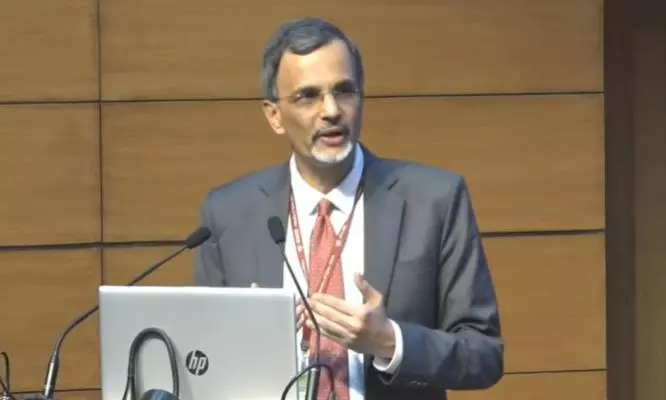
Economic Survey | Slowing growth presents reality check for Viksit Bharat
A key challenge is India's limited capacity to produce critical goods at scale and quality to support its infrastructure and investment ambitions

To realise its economic aspirations of becoming 'Viksit Bharat' by 2047, the centenary of Independence, India needs to achieve a growth rate of around 8 per cent at constant prices, on average, for about a decade or two, according to the Economic Survey 2024-25, prepared by Chief Economic Advisor to the Finance Ministry, Anant Nageswaran.
This might currently seem challenging, considering the real gross domestic product (GDP) growth for FY26 is projected at 6.3-6.8 per cent. The GDP expected to expand by 6.4 per cent in FY25 — the weakest in four years — amid tepid manufacturing activity and sluggish investment.
This is in line with the International Monetary Fund's projection of the growth rate of India's GDP at constant prices at around 6.5 per cent between FY26 and FY30.
Also read | Economic Survey LIVE | GDP growth of 6.3 to 6.8 pc projected for FY26
Economic momentum
Despite India recording a robust 8.2 per cent GDP growth in FY24, maintaining its position as the world’s fastest-growing major economy, concerns over economic momentum persist. Growth had stood at 7.2 per cent in FY23 and 8.7 per cent in FY22, but recent trends indicate a deceleration.
The slowdown was particularly pronounced in Q2 FY25, where GDP growth dropped to a seven-quarter low of 5.4 per cent, down from 8.1 per cent a year earlier and 6.7 per cent in the previous quarter.
According to the first advance estimates of national accounts, India’s real GDP is expected to grow by 6.4 per cent in FY25. Growth in the first half of the fiscal year was driven by strong performances in agriculture and services, supported by record Kharif production and favorable agricultural conditions.
However, the manufacturing sector struggled due to weak global demand and seasonal domestic factors. Private consumption remained steady, reflecting stable domestic demand, while fiscal discipline, a services trade surplus, and healthy remittance inflows contributed to macroeconomic stability, Nageswaran said in the report.
Limited capacity
One of the key challenges India faces is its limited capacity to produce critical goods at the scale and quality necessary to support its infrastructure and investment ambitions. For example, the country’s solar energy sector remains heavily reliant on imports for key components like polysilicon, ingots, and wafers.
Also read | Economic Survey 2024-25: India witnessing GCC boom; to have 30,000 global roles by 2030
While domestic production of monocrystalline silicon ingots is expected to increase fivefold from 2 GW in 2023 to 10 GW by 2025, this will still fall short of meeting national demand. Many solar equipment manufacturers depend on Chinese supply chains, exposing India to risks such as supply disruptions, price fluctuations, and currency volatility, the Economic Survey pointed out. .
Addressing these challenges requires a concerted effort to attract, promote, and facilitate both domestic and foreign investment. However, India is not just competing with other emerging markets but also with advanced economies that are striving to retain their industries.
Strengthening domestic supply-chain capabilities and building resilience will be critical for long-term economic stability. Companies must seek alternative sources of supply and move beyond short-term cost considerations to ensure sustained growth.
Key risks
Looking ahead, India’s economic outlook for FY26 remains balanced. Key risks include geopolitical and trade uncertainties, potential commodity price shocks, and the pace at which private sector order books translate into sustained investment.
Factors such as improving consumer confidence, rising corporate wages, and a rebound in rural demand — supported by stronger agricultural output and easing food inflation — could provide an upside to near-term growth. India must focus on structural reforms and deregulation to reinforce its medium-term growth potential to enhance global competitiveness.
Also read | Income-tax | Direct Tax Code should bring overhaul, not cosmetic changes
On the supply side, real Gross Value Added (GVA) is also projected to grow by 6.4 per cent in FY25. The agriculture sector is expected to rebound with 3.8 per cent growth, while industrial expansion, driven by strong performance in construction and utilities, is estimated at 6.2 per cent.
The services sector is likely to remain the backbone of economic growth, with an anticipated 7.2 per cent expansion, fueled by financial services, real estate, professional services, public administration, and defence.
Signs of recovery
The slowdown in investment activity is expected to be temporary, with early signs of recovery visible. Capital formation is gaining traction, with Union government capital expenditure rising by 8.2 per cent between July and November 2024. The RBI’s Order Books, Inventory, and Capacity Utilization Survey (OBICUS) showed that seasonally adjusted capacity utilization in manufacturing firms stood at 74.7 per cent in Q2 FY25, exceeding the long-term average of 73.8 per cent.
A private sector analysis of capital goods companies revealed a sharp 23.6 per cent increase in order books in FY24, compared to a compound annual growth rate (CAGR) of 4.5 per cent over the preceding four years. Additionally, investment intentions reported by the RBI surged to ₹2.45 lakh crore for FY25, up from ₹1.6 lakh crore in FY24, with spillover investments expected in FY26, the report said.
Imports and exports
On the external front, exports of goods and non-factor services at constant prices grew by 5.6 per cent in H1 FY25, while imports increased by a modest 0.7 per cent. In Q2 FY25, imports of goods and services contracted by 2.9 per cent, largely due to declining commodity prices. This contraction led to a positive net export contribution to GDP growth.
India’s economic expansion continues to be underpinned by stability in inflation, fiscal health, and balance of payments. Moving forward, the country’s ability to sustain growth will depend on its success in boosting investment, diversifying supply chains, and implementing grassroots-level structural reforms to enhance productivity and global competitiveness, the report said.

